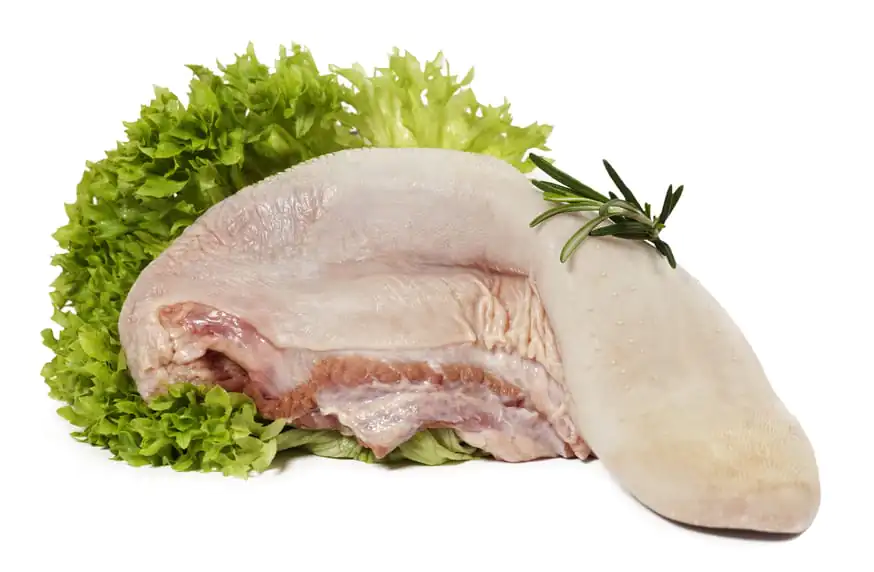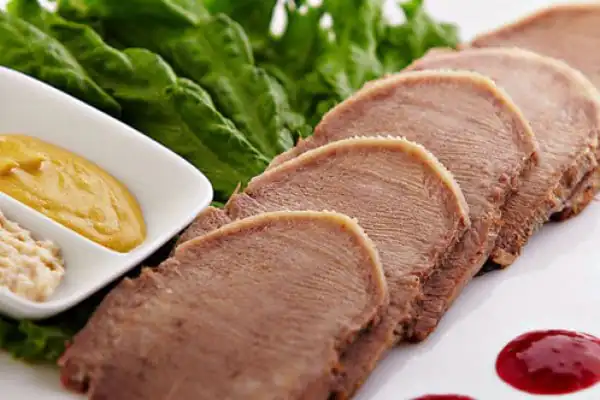Contents
Description
Tongue can rightfully be considered a delicacy. It is delicious, tender and nutritious. Most often, beef and veal tongue is used in culinary recipes, less often pork tongue. Before cooking, it is advised to soak the tongue in cold water, then boil it with salt and spices for several hours. As soon as the tongue becomes soft, it is transferred to cold water, allowed to cool and the skin is removed.
Then they act according to the recipe. The tongue can be cut into thin slices and used for aspic. You can make any meat salad by replacing the meat with pieces of tongue. The tongue can weigh from 200g to 2.5kg and is sold fresh or salted.
A salted tongue should be soaked for 8-10 hours, then boiled without salt, as it contains a sufficient amount of it. The cooking time is about 40 – 60 minutes. Beef tongue is cooked for a long time – about three hours. You can check the readiness like this: pierce the tip of the beef tongue. If it pierces easily, the tongue is ready. After boiling, do not forget to remove the skin from the tongue.
All Kazakhstanis know that if a ram is slaughtered on some occasion, then its head is served first to the most honored guest. The one, cutting the head, at his own discretion determines who will get which piece: an ear, tongue, eye, or a real delicacy – brains. Moreover, if the guest’s father is alive, then the ram’s head will never be served to him, and he himself should not accept it, since no one can be more respectable than his parent.

Composition and calorie content
The beef tongue contains the following components:
- water (70%);
- proteins (13%);
- fats (13%);
- carbohydrates (2%);
- extractive substances;
- vitamins: B1, B2, B3, B6, B12, E, PP;
- magnesium;
- iron;
- calcium;
- sodium;
- copper;
- phosphorus;
- chromium;
- molybdenum;
- iodine;
- sulfur;
- cobalt;
- potassium;
- manganese;
- zinc.
- The cholesterol content in beef tongue is minimal – 150 mg per 100 grams, which makes the product dietary.
The calorie content of beef tongue is 173 kcal per 100 g.
Beef tongue: beneficial properties for the body
One of the most delicious delicacies is beef tongue, the benefits and harms of which we will try to determine, is included in appetizers, salads and aspic. It belongs to the offal with a high gastronomic value, becoming an excellent alternative to regular meat. They can diversify the daily menu by baking, frying, boiling and combining with other ingredients. The composition of the meat product includes many useful substances, but its use will not benefit all people. Let’s take a closer look at the properties of this delicacy.
Finding out how useful beef tongue is, one cannot fail to note the richness of its composition, which determined the great value of the delicacy.

- The product is classified as low-calorie, since it practically does not contain fats.
- It is included in the diet of pregnant women, providing the supply of many vital nutrients necessary for both mother and baby.
- Regular use of the by-product, rich in proteins and trace elements, helps to strengthen the immune system, which serves as a barrier to pathogenic microflora.
- As a natural source of vitamins and minerals, it contributes to the beauty of skin, nails and hair.
- Is beef tongue good for our emotional state? There is no doubt about that. It is an excellent supplier of essential amino acids and proteins that have a beneficial effect on the psyche.
- Restores a weakened body after an operation or a serious illness.
- Regular consumption of this delicacy helps prevent the development of migraines, which are caused by the increased concentration of niacin.
- It has a beneficial effect on anemia due to the iron included in the composition.
- Beef tongue (with all its benefits for the body) is not for nothing considered a valuable product. Its regular use contributes to the normal functioning of the nervous system, due to the high content of B vitamins, which improve the conduction of nerve impulses.
- Experts note the ability of the product to maintain optimal cholesterol levels.
- It is an extremely useful component of the sports menu, which quickly restores strength.
- Helps to alleviate the condition of diabetics, due to the presence of bioactive substances involved in the production of insulin.
- The useful properties of the beef tongue can also include the ability to accelerate the regeneration of the skin with any injury. This quality is ensured by the abundance of zinc.
- The offal is recommended to be included in the diet of adolescents and children. Its valuable composition will support the child’s body at the time of development, especially during puberty.
Contraindications
The most serious contraindication is individual intolerance to the fibers of the product, but this phenomenon is extremely rare. Although beef tongue is easy to digest, easier to digest than any other type of muscle tissue, it is not recommended for those people who generally contraindicate meat products. Otherwise, the load on the kidneys and liver increases, and there is a threat of a decrease in immunity. Such problems with the assimilation of foods usually occur in old age, in this case it is worth refusing to use the Tongue.

Since most of the listed phenomena and heaviness in the stomach arise as a result of the body trying to digest the hard shell, it should be removed after boiling the tongue, and then boil the beef tongue already in a purified form.
Although the composition contains about 13% fat, this is twice as much as in the liver. To keep the food in the diet, it is enough to reduce the consumption.
Experts, comparing the benefits and harms of using beef tongue, come to an unequivocal conclusion: the positive effect of it is much more significant than the negative phenomena. People who have chronic diseases of the digestive system should eat this meat with caution.
Cooking applications
Of the various methods of preparing the tongue, cooking is most often used. The tongue is usually boiled for about 3 hours, while it increases significantly in size.
Boiled tongue can be used as an independent snack or one of the ingredients in various dishes. More often it is added to all kinds of salads, julienne, aspic dishes.
There are a lot of options for garnish for boiled tongue. The simplest and most common option is boiled potatoes or mashed potatoes from them. The tongue is often combined with pickled mushrooms, capers, artichokes, green peas. In some cuisines of the world, salted watermelon is served with boiled tongue.

When preparing beef tongue, rarely add any seasoning. Usually they are limited to a standard set – bay leaves, salt and ground pepper. When boiling the tongue, onions and carrots are often added to the water. In dietary nutrition, the tongue is used without any spices and only boiled.
In salads, beef tongue is mixed with all kinds of ingredients. It can be various vegetables and herbs, eggs, mushrooms, prunes, green peas, cheese, ham, chicken, seafood. The tongue can be used instead of meat in any salad, such as Olivier. Boiled tongue can be the basis for stuffed rolls. Mushrooms, nuts, eggs, herbs, various vegetables are perfect as a filling,
In Asia, beef tongue is marinated in soy sauce with bell peppers and spices.
There are many beef tongue recipes in French cuisine. The boiled tongue can be used as a base for various dishes – in this case, it is usually pre-aged in a marinade.
Beef tongue can not only be boiled, but also stewed. More often it is stewed in red wine, soy sauce, sour cream or cream. The tongue is also baked or fried in batter or breadcrumbs.
In Georgian cuisine, boiled tongue is stewed with mushrooms, carrots and onions in a nut-garlic sauce. Another option for preparing the tongue in Georgia is roasting on a spit.
In Italian cuisine, canapes are made from boiled tongue, adding pickled cucumbers and cheese. In addition, Italians put their tongue in their famous dishes – pizza and pasta.
In China, beef tongue is used to prepare various salads, boil it with all kinds of spices, and bake it in dough.
In Brazilian cuisine, beef tongue is stewed in red wine with onions, herbs and spices, or beans and fresh vegetables.
In America, the tongue is cooked with vegetables and spices with a peanut sauce.
Beef tongue is added to various sausages, ham, smoked meats, and canned food is made from it.
Due to its benefits, beef tongue is used not only in dietary food, but also in baby food (from 10-12 months).
Boiled calf tongue

Ingredients
- Beef tongue 1
- Onion 80
- Pepper peas 8
- Bay leaf 3
- Salt to taste
COOKING METHOD
- Cut off the salivary glands from the tongue, cut off excess fat, wash thoroughly under running water.
- Put your tongue in a saucepan and cover with water, put on fire, bring to a boil.
- When the water boils, boil your tongue for literally 1-2 minutes, then drain the water, rinse your tongue and fill it with clean water.
- Send the pan over the heat again, let the broth simmer, reduce the heat to medium and simmer for about half an hour, then season with salt. Do not forget to remove the foam.
- Peel the onion, wash and send it whole to the broth, add bay leaves and peppercorns, cook for one and a half to two hours (readiness can be checked with a knife: if it comes in easily, the meat is ready).
- Remove the tongue from the broth and lower it into a container with cold water (you can use the cold water tap – the result is the same), then, starting from the tip, carefully remove the skin.
Cut the tongue into thin slices and serve on a platter.
Serve, treat your family. Enjoy your meal!










הכתבה יכלה להיות מאוד יפה אם לא היית מזכירה את המילה
.המשוקצת “חזיר” כאופציה לבישול .
במדינת היהודים לא אוכלים ולא רוצים לערבב את שם הדבר הטמא והמשוקץ הזה גם בתוך ספר מתכונים.
זה אומנם טעים כמו שהגמרא אומרת אבל זה גועל נפש רק מלחשוב על כך שיש יהודים שלצערנו צורכים את הדבר אחר הזה
יהי רצון שה’ יחזיר אתכם בתשובה שלמה